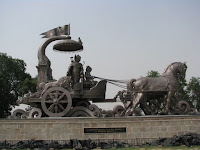 |
Shiva statue (1300 CE) |
A blog dedicated to philosophy, history, politics, literature
Pages
Friday, December 23, 2022
Shiva: The Mahabharata’s God of Vengeance
Thursday, December 22, 2022
Bhishma and the Kuru Bloodline
 |
Vyasa with Satyavati (Geeta Press Illustration) |
Wednesday, December 21, 2022
The Sons of Indra and Surya
 |
Sunrise in Uttarakhand |
Who Controls Social Media and Mainstream Media?
Tuesday, December 20, 2022
A View of the Mahabharata War
 |
Statue of Krishna and Arjuna in chariot Kurukshetra (Haryana) |
Monday, December 19, 2022
Garuda and the Metaphysics of Death and Rebirth
 |
Vishnu and Lakshmi on Garuda (12th century sculpture) |
Sunday, December 18, 2022
The Four Sons of Lord Shiva
 |
The Pashupati Seal Depicting Shiva Mohenjo-Daro (2350–2000 BCE) |
Saturday, December 17, 2022
Aurobindo: Nationalism is the Work of God
 |
Copy of Bande Mataram Edited by Sri Aurobindo September 1907 |
Friday, December 16, 2022
Ram Mohan Roy’s View of Sanskrit Education
 |
Stamp Dedicated to the Sanskrit College (Issued in 1999) |
Thursday, December 15, 2022
The Master of Eclipses: Rahu and Ketu
 |
Statue of Mohini (Avatar of Vishnu) |
Wednesday, December 14, 2022
The Sutras and Bhasyas of the Six Schools of Hindu Philosophy
 |
Shankaracharya with disciples Painting by Raja Ravi Varma |
Tuesday, December 13, 2022
Language and Grammar in the Vedic Age
 |
Birch bark manuscript from Kashmir of Panini’s Rupavatara |
Monday, December 12, 2022
India’s Unlikely Hero: P. V. Narasimha Rao
 |
P. V. Narasimha Rao |
Sunday, December 11, 2022
Sankhya and Yoga in the Mahabharata
 |
Bhishma Lying on the Bed of Arrows |
Saturday, December 10, 2022
Naubandhana Peak of the Vedic Age: Mt. Everest of Our Time
Friday, December 9, 2022
What Can Narendra Modi Learn from George H.W. Bush
 |
Netanyahu and Modi Tel Aviv 2017 |
Thursday, December 8, 2022
Gandhi and Nehru
Wednesday, December 7, 2022
Is Journalism the First Draft of History?
Tuesday, December 6, 2022
On Bharavi’s Kiratarjuniya
 |
Shiva granting Pashupatastra to Arjuna |
Monday, December 5, 2022
Yoga in Katha, Shvetashvatara, and Maitri Upanishads
 |
Statue of Patanjali, (Haridwar) |
Sunday, December 4, 2022
The Subversive Character of History
Saturday, December 3, 2022
Shriharsha: The Philosopher and Poet of the Middle Ages
 |
Nala leaving Damayanti while she sleeps (Raja Ravi Varma’s painting) |
Friday, December 2, 2022
Ferguson’s Conception of the West’s Challenger
 |
Grinning Nixon meets Dour Mao (21 Feb 1972) |



